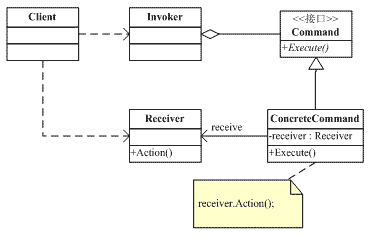我们去餐厅吃饭,我们是通过服务员来点菜,具体是谁来做这些菜和他们什么时候完成的这些菜,其实我们都不知道。抽象之,“菜单请求者”我们和“菜单实现者”厨师,2者之间是松耦合的,我们对这些菜的其他一些请求比如“撤销,重做”等,我们也不知道是谁在做。其实这就是本文要说的Command模式。
将一个请求封装为一个对象,从而使你可用不同的请求对客户进行参数化;对请求排队或记录请求日志,以及支持可撤消的操作。[GOF 《设计模式》]
UML类图:

代码实现:
// Command.cpp : 定义控制台应用程序的入口点。 // #include "stdafx.h" #include <iostream> #include <string> #include <vector> #include <ctime> using namespace std; // 烤肉师傅 class RoastCook { public: void MakeMutton() { cout << "烤羊肉" << endl; } void MakeChickenWing() { cout << "烤鸡翅膀" << endl; } }; // 抽象命令类 class Command { public: Command(RoastCook* temp) { receiver = temp; } virtual void ExecuteCmd() = 0; protected: RoastCook* receiver; }; // 烤羊肉命令 class MakeMuttonCmd : public Command { public: MakeMuttonCmd(RoastCook* temp) : Command(temp) {} virtual void ExecuteCmd() { receiver->MakeMutton(); } }; class MakeChickenWingCmd : public Command { public: MakeChickenWingCmd(RoastCook* temp) : Command(temp) {} virtual void ExecuteCmd() { receiver->MakeChickenWing(); } }; // 服务员类 class Waiter { public: void SetCmd(Command* temp); // 通知执行 void Notify(); protected: vector<Command*> m_commandList; }; void Waiter::SetCmd(Command* temp) { m_commandList.push_back(temp); cout << "增加订单" << endl; } void Waiter::Notify() { vector<Command*>::iterator it; for (it=m_commandList.begin(); it!=m_commandList.end(); ++it) { (*it)->ExecuteCmd(); } } int _tmain(int argc, _TCHAR* argv[]) { RoastCook* cook = new RoastCook(); Command* cmd1 = new MakeMuttonCmd(cook); Command* cmd2 = new MakeChickenWingCmd(cook); Waiter* girl = new Waiter(); // 点菜 girl->SetCmd(cmd1); girl->SetCmd(cmd2); // 服务员通知 girl->Notify(); system("pause"); return 0; }